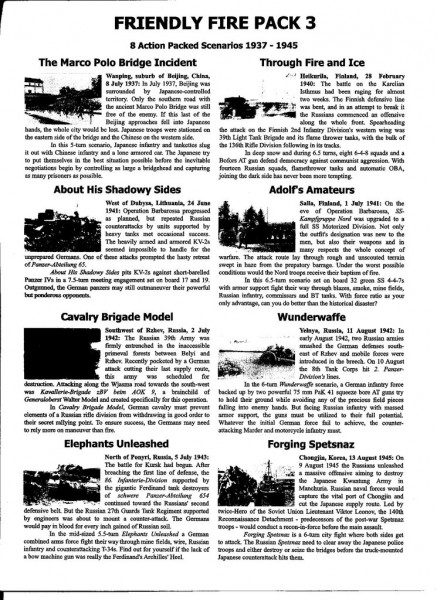
- Order number: FRF003
From the Publisher:
Friendly Fire Pack 3 contains eight scenarios featured in the Friendly Fire 2007 ASL tournament held in Linköping, Sweden.
Friendly Fire Pack 3 does not include any counters. However, we've produced a number of hand-made PaK 41 counters for the FrF22 Wunderwaffe scenario. These counters are primarly for playtesters and other people who've helped us out.
Scenarios: 8
Year of Publication: 2007
Average Scenario ROAR Recommendation: 6.6
Average Scenario ROAR Balance: 46% - 54%
FrF17 The Marco Polo Bridge Incident

Wanping, suburb of Beijing, China, July 8, 1937: In July 1937, Beijing was surrounded by Japanese-controlled territory. Only the southern road with the ancient Marco Polo Bridge was still free of the enemy. If this last of the Beijing approaches fell into Japanese hands, the whole city would be lost. Japanese troops were stationed on the eastern side of the bridge and the Chinese on the western side.
In this 5-turn scenario, Japanese infantry and tankettes slug it out with Chinese infantry and a lone armored car. The Japanese try to put themselves in the best situation possible before the inevitable negotiations begin by controlling as large a bridgehead and capturing as many prisoners as possible.
Designer: Martin Svärd
ROAR Recommendation: 6.83
ROAR Record: Chinese 38 (56%) - Japanese 30 (44%)
FrF18 Through Fire and Ice

Heikurila, Finland, February 28, 1940: The battle on the Karelian Isthmus had been raging for almost two weeks. The Finnish defensive line was bent, and in an attempt to break it the Russians commenced an offensive along the whole front. Spearheading the attack on the Finnish 2nd Infantry Division's western wing was 39th Light Tank Brigade and its flame thrower tanks, with the bulk of the 136th Rifle Division following in its tracks.
In deep snow and during 6.5 turns, eight 6-4-8 squads and a Bofors AT gun defend democracy against communist aggression. With fourteen Russian squads, flamethrower tanks and automatic OBA, joining the dark side has never been more tempting.
Designer: Martin Svärd
ROAR Recommendation: 6.4
ROAR Record: Finnish 16 (50%) - Russian 16 (50%)
FrF19 About His Shadowy Sides

West of Dubysa, Lithuania, June 24, 1941: Operation Barbarossa progressed as planned, but repeated Russian counterattacks by units supported by heavy tanks met occasional success. The heavily armed and armored KV-2s seemed impossible to handle for the unprepared Germans. One of these attacks prompted the hasty retreat of Panzer-Abteilung 65.
About His Shadowy Sides pits KV-2s against short-barelled Panzer IVs in a 7.5-turn meeting engagement set on board 17 and 19. Outgunned, the German panzers may still outmaneuver their powerful but ponderous opponents.
Designer: Erik Leander
ROAR Recommendation: 6.65
ROAR Record: German 55 (56%) - Russian 43 (44%)
FrF20 Adolf's Amateurs

Salla, Finland, July 1, 1941: On the eve of Operation Barbarossa, SS-Kampfgruppe Nord was upgraded to a full SS Motorized Division. Not only the outfit's designation was new to the men, but also their weapons and in many respects the whole concept of warfare. The attack route lay through rough and unscouted terrain swept in haze from the prepatory barrage. Under the worst possible conditions would the Nord troops receive their baptism of fire.
In this 6.5-turn scenario set on board 32 green SS 4-4-7s with armor support fight their way through blazes, smoke, mine fields, Russian infantry, commissars and BT tanks. With force ratio as your only advantage, can you do better than the historical disaster?
Designer: Mattias Rönnblom
ROAR Recommendation: 6.16
ROAR Record: German 32 (50%) - Russian 32 (50%)
Question: What happens if a SS 4-4-7/2-3-7 is subject to Unit Replacement?
Answer: An unbroken SS 4-4-7 which fails a MC with > ELR (3) is turned into two broken (but not disrupted) SS 2-3-7 HS. An unbroken SS 2-3-7 suffering the same fate is broken (but not disrupted).
The MMCs are SS (A25.11), and thus have underline morale. Units with underlined morale which are assigned ELR by SSR (which is the case here) suffers Unit Replacement normally (A19.132). However, a Unit Replacement requires a lesser Class (A19.13), and since the SS 4-4-7s are Green (per SSR) they are already at the bottom of the ladder. Such Units would normally be Disrupted (A19.12), but SS units vs Russians does not Disrupt (A25.11).
FrF21 Cavalry Brigade Model

Southwest of Rzhev, Russia, July 2, 1942: The Russian 39th Army was firmly entrenched in the inaccessible primeval forests between Belyi and Rzhev. Recently pocketed by a German attack cutting their last supply route, this army was scheduled for destruction. Attacking along the Wjasma road towards the south-west was Kavallerie-Brigade zBV beim AOK 9, a brainchild of Generaloberst Walter Model and created specifically for this operation.
In Cavalry Brigade Model, German cavalry must prevent elements of a Russian rifle division from withdrawing in good order to their secret rallying point. To ensure success, the Germans may need to rely more on maneuver than fire.
Designer: Mattias Rönnblom
ROAR Recommendation: 6.61
ROAR Record: German 12 (41%) - Russian 17 (59%)
FrF22 Wunderwaffe

Yelnya, Russia, August 11, 1942: In early August 1942, two Russian armies smashed the German defenses south-east of Rzhev and mobile forces were introduced in the breech. On 10 August the 8th Tank Corps hit 2. Panzer-Division's lines.
In the 6-turn Wunderwaffe scenario, a German infantry force backed up by two powerful 75 mm PaK 41 squeeze bore AT guns try to hold their ground while avoiding any of the precious field pieces falling into enemy hands. But facing Russian infantry with massed armor support, the guns must be utilized to their full potential. Whatever the initial German force fail to achieve, the counter-attacking Marder and motorcycle infantry must.
Designer: Mattias Rönnblom
ROAR Recommendation: 6.54
ROAR Record: German 26 (45%) - Russian 32 (55%)
FrF23 Elephants Unleashed

North of Ponyri, Russia, July 5, 1943: The battle for Kursk had begun. After breaching the first line of defense, the 86. Infanterie-Division supported by the gigantic Ferdinand tank destroyers of schwere Panzer-Abteilung 654 continued toward the Russians' second defensive belt. But the Russian 27th Guards Tank Regiment supported by engineers was about to mount a counter-attack. The Germans would pay in blood for every inch gained of Russian soil.
In the mid-sized 5.5-turn Elephants Unleashed a German combined arms force fight their way through mine fields, wire, Russian infantry and counterattacking T-34s. Find out for yourself if the lack of a bow machine gun was really the Ferdinand's Archilles' Heel.
Designer: Martin Svärd
ROAR Recommendation: 6.83
ROAR Record: German 50 (49%) - Russian 53 (51%)
FrF24 Forging Spetsnaz

Chongjin, Korea, August 13, 1945: On 9 August 1945 the Russians unleashed a massive offensive aiming to destroy the Japanese Kwantung Army in Manchuria. Russian naval forces would capture the vital port of Chongjin and cut the Japanese supply route. Led by twice-Hero of the Soviet Union Lieutenant Viktor Leonov, the 140th Reconnaissance Detachment - predecessors of the post-war Spetsnaz troops - would conduct a recon-in-force before the main assault.
Forging Spetsnaz is a 6-turn city fight where both sides get to attack. The Russian Spetsnaz need to clear away the Japanese police troops and either destroy or seize the bridges before the truck-mounted Japanese counterattack hits them.
Designer: Mattias Rönnblom
ROAR Recommendation: 6.69
ROAR Record: Japanese 20 (43%) - Russian 27 (57%)
Question: Why do the Russians benefit from blowing bridges?
Answer: On the operational level, the aim is to cut the supply for the Kwantung Army fighting in Manchuria. On the tactical level, the Russian Spetsnaz recon force aim to hamper Japanese redeployment/reinforcements by cutting the bridges, either by their destruction or by covering them by fire. The massive Russian assault is yet to come when the scenario takes place.
Präsentationsort im Laden: Ihr findet mich im Regal W17.


